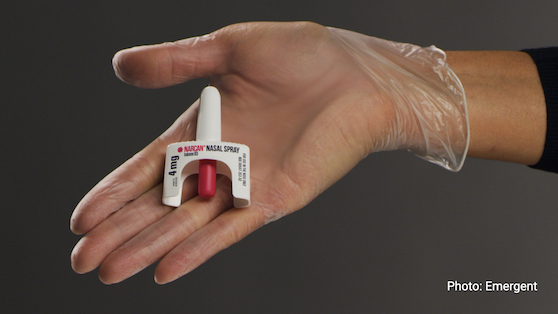
Articles
Business
Features
News
Articles
Safety
Safety News
New naloxone requirements in Ontario: do you need to comply?
July 5, 2023 | By Workplace Safety & Prevention Services
“Opioid overdoses can happen tomorrow”
 Example of a naloxone nasal spray. Photo shown for illustration purpose only. Source: Emergent.
Example of a naloxone nasal spray. Photo shown for illustration purpose only. Source: Emergent. July 5, 2023 – Recent amendments to Ontario’s Occupational Health & Safety Act—which came into effect June 1—require life-saving naloxone kits in workplaces where workers are deemed at risk of overdose.
Naloxone is a medication that temporarily reverses the effects of an opioid overdose and allows time for medical help to arrive.
According to the province, roughly 2500 people died from opioid-related causes between March 2020 and January 2021. Of the victims who were employed, 30% were construction workers—“by far the most of any industry impacted”.
The province is offering guidance on how to determine whether your workplace must comply with new naloxone requirements, as well as support in the form of a free naloxone kit and training for two workers.
What are the new legal requirements?
Workplaces at risk of a worker opioid overdose must have at least one (1) naloxone kit onsite and train staff on administering it. Note: the requirements only apply when your own workers are at risk, not others who may be in the workplace.
“A workplace can decide to provide multiple kits, depending on the degree of risk and the size of the workplace, in order to meet the legal obligation to take every reasonable precaution to protect workers,” says Pam Patry, WSPS consultant.
Determining risk of worker opioid overdose
When you are aware of—or ought to be aware of—a risk of overdose, the regulations apply to you. “There are five ways you might become aware of a risk of worker opioid overdose,” Patry notes:
1. A worker opioid overdose has already occurred in the workplace.
2. A worker who uses opioids voluntarily discloses this risk.
3. Opioid use is observed in the workplace or discovered during a workplace investigation.
4. Discarded opioid paraphernalia, such as needles, are found in the workplace.
5. The joint health & safety committee (JHSC) or others in the workplace bring the risk to the employer’s attention.
“If workplaces are still unsure of their status, they can opt to purchase a kit and provide training on its use to be on the safe side,” says Patry.
How many staff need to be trained, and on what?
“The requirements only say trained staff must be available to administer naloxone anytime there are workers in the workplace,” says Patry. “You’ll need to take into consideration vacation, sick days, shifts, and the number of naloxone kits you have when determining how many people require training.”
Those kits must be located in the vicinity of trained staff.
Training covers how to recognize an opioid overdose, how to administer naloxone, and hazards related to administering naloxone. Depending on the form in which the naloxone is administered (nasal spray or injection), these hazards could include physical, chemical, biological and psychological.
What supports are available to help comply?
Ontario’s Workplace Naloxone Program will provide support to employers for up to two years by providing free online naloxone training for two (2) workers per workplace and a free nasal spray naloxone kit. Visit program providers, such as the Canadian Red Cross or St. John Ambulance.
Incorporating naloxone kits into existing plans
“Follow the process you use for other first aid emergencies,” says Patry. Set down, in writing:
• who administers the naloxone
• where kits are stored
• training that is required
• procedures to follow when administering naloxone
• who to contact, externally and internally
• controls you have in place to prevent identified hazards
• personal protective equipment that must be worn
• how you will support first aid providers and other employees affected by the incident
Should you find that your workplace needs to comply with the requirements, then don’t delay, Patry concludes. “Opioid overdoses can happen tomorrow.”
A not-for-profit organization, Workplace Safety & Prevention Services is the largest health and safety association in Ontario, supporting the agricultural, manufacturing, and service sectors. WSPS is a partner in Ontario’s OHS system, which includes the Ministry of Labour, Immigration, Training and Skills Development (MLITSD), Workplace Safety & Insurance Board, and five other organizations.
You’ll find all Back Issues of Electrical Business Magazine in our Digital Archive.
Print this page
